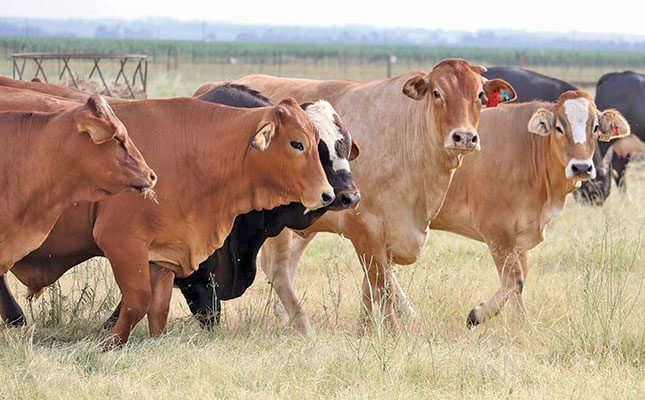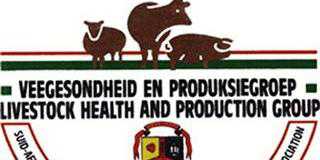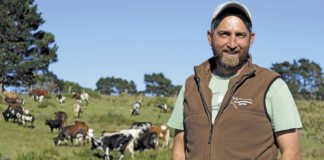
Photo: JHB Premium Simbras
According to Rocco Botha, the Klipveld near Lichtenburg in North West is no easy place to farm cattle.
“The challenges not only come with the terrain being very rocky and the winters being dry and harsh, but also with ticks and tick-borne diseases in the summer months.
“European breeds are more likely to have a harder time under these conditions. I therefore decided on the Simbra because of its hardiness, adaptability to extreme farming conditions and relative resistance to pests and diseases. An added factor is the Simbra cow’s strong maternal ability, with abundant milk and unequalled parental instinct,” he says.
Botha runs more than 1 000 Simbras on 13 000ha that stretches from the west to the east side of Lichtenburg. The average yearly precipitation is between 400mm and 500mm and the Klipveld consists mainly of sourveld with isolated spots of sweetveld.
The grazing is made up of prominent grasses such as red grass (Themeda triandra) and other indigenous grasses, as well as indigenous trees and shrubs. Alien species are continually eradicated from the veld.
Fertility and milk
Botha’s breeding philosophy is to breed fertile cows with high milk and meat properties. He prefers medium- to large-framed animals with a smooth dark skin, long ears and a white face.
“Performance testing is one of the most critical points when it comes to our structures and implementation of our management style on the farm. Our commercial herd is tested for pregnancy three to four times a year while the bulls’ performance, fertility and possible deficiency are tested two to three times a year. We source genetics from well-known breeders with a proven track record,” he says.
Grazing management
The farming operation is based on four camp systems of 150ha each per 100 head of cattle on a rotational basis. Each camp has its own watering point, and in some there are two watering points.
“In early summer, when toxic plants such as slangkop (Urginea burkeii) and gifblaar (Dichapetalum cymosum) sprout first, we move the cattle to a different camp each week. After the first good rains and when the grazing is in optimal condition, the cattle are moved only every three to four weeks. The main objective is to utilise as much of the available grazing as possible in a sustainable manner.
“Obviously, the management of any herd, no matter its size, is of utmost importance. By dividing the herd into groups of manageable size, each herd enjoys the same attention without the huge numbers of one big herd swamping the task at hand.
“When working with the animals, we don’t allow a timeline to decide the pace we need to work at. We rather give our full attention to the herd at the specific time and ensure that we don’t miss anything. A very strict programme is adhered to when it comes to tagging, dosing, weaning, counting, and the general well-being of all our animals.
“Each herd is overseen by a herdsman who is responsible for counting the animals daily and reporting all cases of sick animals. Normally, the farm manager inspects each herd every second to third day, unless a crisis arises and animals need special attention. We work on a density of 6ha/ MLU, and this is enough to carry the animals throughout the year,” Botha explains.
The herd currently consists of 1 620 commercial breeding cows, 890 heifers and 105 bulls, but Botha’s aim is to increase the number of breeding cows to 2 000 over the next two years.
His goal is to have at least four bulls for every 100 females, with one bull on the reserve bench, so to speak. According to him, a standby bull is necessary because the dominant bull in a herd works harder than the other bulls and needs some rest. The dominant bull is therefore removed from the herd regularly for a three-month rest period, after which he is brought back to the cows.
Artificial insemination
Thirty percent of the heifers selected to go on auction are artificially inseminated (AI). The outstanding bulls in the herd are selected each year for the AI process. Botha plans to increase the number of heifers undergoing AI by 50% in the coming year.
“A well-planned and executed AI programme makes economic sense and allows broader access to top genetics,” he says.
“We don’t have a specific breeding season, but rather spread our calving throughout the year. One of the benefits is that we’re able to market our bull calves throughout the year. Although we don’t have a specific breeding season, most calves are born in October, November or December.”
Commercial calves are not weighed at birth, but substandard calves are recorded. If this proves to be an ongoing problem, the cow or bull is taken out of the breeding system and replaced. The calves are weaned at the age of at least six months. This gives the cow enough time to recover and be optimally receptive, and to tend successfully to her new calf when it is born.
\
Females and males are separated upon weaning. Depending on the market demands at the time, the male weaners are either feedlotted on Botha’s farm or sold to feedlotters.
Upon weaning, the heifers viable for Botha’s auction programme are selected. These animals are allowed to grow out on the veld, with an added production mix supplement.
Once the females’ target weight of 360kg has been reached, the bulls are put with them. This means that between 350 and 400 heifers are bred twice a year. The pregnant heifers are marketed on two production auctions per year, each offering 300 heifers.
Between 150 and 200 heifers are retained as replacements, ensuring that Botha keeps the breeding herd young and closed.
Disease management
Botha’s disease management regime allows for dosing twice a year, at the start of summer and winter, against the diseases occurring in the area. These include heartwater on some of the farms, and gallsickness.
After the first rains in summer and again after the last rains, the animals are treated against Clostridium bacteria, infectious bovine rhinotracheitis, bovine viral diarrhoea, botulism and pasteurellosis.
The animals are also treated with Virbac’s Multimin and Pro-Vit A and long-acting ivermectin to increase the efficacy of the medication.
Supplying commercial beef producers
Botha considers South African commercial beef cattle producers as his most valued end clients and says it is his business’s mission and vision to supply them with best-quality animals for optimal production and return on investment.
According to him, the current cost of red meat production leaves no space for poorly performing or non-performing animals.
To accommodate a poor performer costs just as much as maintaining a top-performing animal. Although the initial capital investment for an animal of improved quality is higher, the return on investment is rapid.
“The biggest mistake I’ve made was to think that by acquiring cheaper animals, I would maintain the same profitability as farming quality animals. I’ve learned the hard way that you get what you pay for.
“However, I’ve also learned that it’s never too late to change direction, and once I decided not to compromise on quality, the business dynamics changed markedly,” he explains.
Small Simbra stud on the side
Botha’s enterprise also includes a small stud of 60 cows to supplement the commercial herd. He points out that his objective is not to run a huge stud with hundreds of animals, but to have a stud based upon the best genetics on offer, and then to select the best bulls amongst them for his commercial herd.
Botha expresses positivity about the future of the local red meat industry. He says cattle breeding in South Africa has made big strides over the past decade and this trend is set to continue. This is underpinned by, amongst other factors, the influx of new breeders following the implosion of the exotic wildlife industry.
South African beef cattle breeders are already counted as among the best worldwide, and he expects this to increase in future and open up new markets for the industry.
“The world population breached the eight billion mark in 2022, and is expected to reach 10 billion in 2050. The fact is that people must eat, and with a culture change in the eastern parts of the world, beef and mutton are becoming the preferred protein and are now more accessible than ever, favouring commercial breeders tremendously,” says Botha.
Email Rocco Botha at [email protected].











